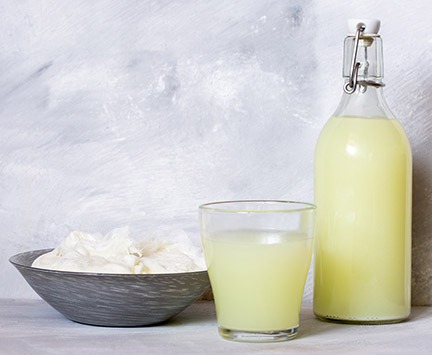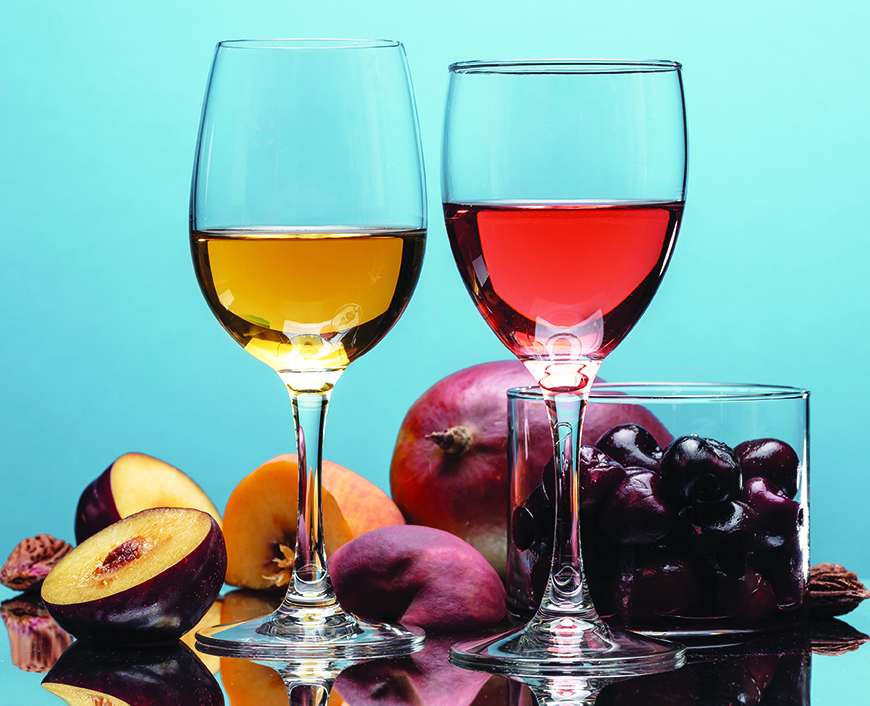Single Varietal Mead Making
In its simplest form mead is a fermented beverage made from honey and water. The key to making fantastic meads is your honey, so don’t think of honey as a generic ingredient — it’s so much more.
Honey is a complex mixture of sugars, flavors from the pollen as well as trace enzymes, minerals, vitamins, and amino acids. The majority of the honey found in grocery stores is Wildflower honey, which is a blend of different honeys made with the goal of producing honey that is consistent in flavor and color. This type of honey is not the same as the Wildflower (or other varietal) honey you can find from a local beekeeper, which isn’t likely to be a blend, and will differ based on time of year harvested, rainfall, and the types of flowers the bees visit. Store-bought honey is fantastic for making melomel (meads made with the addition of fruit); however I highly recommend using a single varietal honey, which is a type of honey derived predominantly from the nectar of one flower, for making traditional meads.
Varietal Honey
Bees are efficient; they fly to the closest flower sources possible looking for nectar. So when a beekeeper places a hive in a given field and harvests the honey after the bloom, the result is that flower’s varietal honey. The color, flavor, and even aroma of a particular variety of honey may differ depending on the nectar source of flowers visited by the honeybees. The colors may range from nearly colorless to dark brown (see the photo above), the flavor may vary from delectably mild to distinctively bold, and even the aroma of the honey may be mildly reminiscent of the flower.
There are more than 300 unique types of honey available in the United States alone, each originating from a different floral source. As a general rule, the flavor of lighter colored honeys is milder, and the flavor of darker colored honeys is stronger. Varietal honeys can be compared to varietal wine in terms of annual climactic changes. The same flower blooming in the same location may produce slightly different nectar from year-to-year depending upon temperature and rainfall (bees don’t go out looking for nectar when it’s raining). To locate specific varietals of honey available near you, try visiting the National Honey Board’s Honey Locator website, http://www.honeylocator.com
Making Varietal Mead
Other than the honey, the other key elements to making a good single-varietal mead (or any mead for that matter) are water, nutrients, yeast, and yeast health.
Water is as critical as the honey selection, using spring water or other water that is free of chlorine and bacteria is essential. If you have very hard water consider diluting a percentage of your water with distilled or reverse osmosis (RO) water.
As with brewing, the yeast you use will make all the difference to the mead you make. I would avoid using Champagne yeast as it tends to dry out the mead too much. My go-to yeast strain for mead making is Lalvin Narbonne 71B-1122 dry yeast, which I use commercially for everything we make at Moonlight Meadery in Londonderry, New Hampshire. As a home mead maker I have also had success with Lalvin ICV D-47 dry yeast. You also have many good choices on mead yeast from White Labs, and Wyeast, including White Labs WLP720 (Sweet Mead/Wine Yeast) and Wyeast 4184 (Sweet Mead) or 4632 (Dry Mead).
Healthy yeast and temperature control are essential for running a clean mead fermentation with less chance of off-flavors or the production of higher alcohols (fusels). Honey does not have the same amount of yeast assumable nitrogen (YAN) as you would find in malt or fruit, which is important as the yeast needs this to stay viable throughout fermentation. When making mead, it is also essential to add the yeast nutrients over the course of several days. This process can be as simple as taking the total amount of nutrients needed for the batch and dividing into four parts, adding one portion of nutrients every 24 hours until they are gone. This process is known as “staggered nutrient additions” and provides the key nutrients to the yeast cells during their growth phase. Think of it as giving the new generations of yeast what they need when they need it. I also use a slightly different method at the meadery, which is a little simpler (and good for making multiple large batches), where I add the last nutrient addition at the 72-hour mark, instead of at 30% depletion of sugar. As you become a more experienced meadmaker, you can experiment with nutrient additions to find what works best for you.
I prefer to use Fermaid K (yeast energizer) and Go-Ferm (an organic yeast nutrient) for adding the additional nutrient requirements of the yeast during mead fermentation. An alternative to Go-Ferm is diammonium phosphate (DAP). All of these nutrients should be available at your local homebrew or home winemaking supplier. The choice of what to use is up to the mead maker; as long as the yeast have nitrogen and oxygen they will continue in the growth phase. Once the yeast cells have grown, get out of the way and let them do what they do best — ferment sugar into ethanol.
Tip: When adding yeast nutrients to your must (unfermented mead) you want to start off by pulling a 1⁄2 cup of the must, mix the nutrient blend, then SLOWLY add it back to the fermenter. Once the nutrients are added then begin to slowly stir the must to release the main portion of the CO2 gas. After the foaming subsides you can begin to stir more vigorously. Mix the must well enough to introduce plenty of oxygen into the fermenting must.
Mead Methodology
Most of the traditional mead recipes that I make, especially when making a varietal mead, follow this ratio: 1 part honey, 3 parts water. Using that ratio, it’s easy to scale down or up a batch as needed. This should get you in the range of a 1.120 starting gravity (SG). In a recent mead experiment I sourced 3 lbs. (1.4 kg) of 60 different types of honey, added 1.5 quarts (~1.5 L) of water, and made several different varietal meads. An experiment like this is a good way to put all those 1-gallon (3.8-L) growlers you have collected to work as mini-fermenters, as single varietal honey is expensive. It’s also a great way to make sample batches of mead with different varietals of honey to find the ones you like. In my base recipe on page 74, find the honey you like best and follow the directions to make a full 5 gallons (19 L).
For a “regular” sized batch (5 gallons/19 L) of mead, you will need (at minimum): A 6-gallon (23-L) food-grade fermenter with a lid and airlock (what you use to brew beer is fine), a 5-gallon (19-L) secondary fermenter (a glass or PET carboy), 15 lbs. (6.8 kg) of a varietal honey (see the sidebar on page 73), a clean water source (see what I said earlier about water), yeast nutrients, your chosen yeast, a calibrated hydrometer setup, a siphon, and of course your cleaning and sanitizing agents of choice. The meadmaking process is more akin to making wine than beer — no boiling – so you can leave your brewpot to the side for this project.
Viva Varietal
The complexity of making single varietal mead is much like making fine wine — choose a good honey source and keep the meadmaking simple to let the honey character shine through. Source the best, most interesting honeys and with a clean fermentation, the proper nutrients, cleanliness and patience, you can make a world-class mead that will express the nuances of your honey.
Varietal Honey Choices
Some of the honey varietals that I like to use for meadmaking include: Tupelo, Orange Blossom, Star Thistle, Cranberry, Almond, Brazilian Peppercorn, and Arizona Pecan Blossom. As with many ingredients, the more honey you buy the better the price break you can negotiate, even on a small scale. You can expect to pay more than $8 per pound for honey. I purchase the majority of the honey for Moonlight Meadery from Dutch Gold in Pennsylvania and they have been very helpful to us as we have grown.
I am not a fan of Buckwheat or Pumpkin Blossom honey, and I also can’t say that I am overly thrilled with Heather Blossom honey either. These varietals of honey tend to taste extremely earthy when they are fermented. I have customers at the meadery who absolutely adore that earthiness, but for me it’s a bit challenging — it’s really up to you as a mead maker to decide what you like.
Here is a list of some of the most common honey varietals you may be able to buy near where you live, and my thoughts on using them for mead making:
Alfalfa
A white or extra light amber-colored honey. It has a mild flavor and aroma that is reminiscent of beeswax. It’s OK for meads, but not extremely popular.
Almond
A great candidate for making into mead. It is light in aroma and its flavor has a slight nuttiness. Almond honey is one of our meadery’s most requested single-varietal meads, and also my mother’s personal favorite.
Arizona Wild Mountain Pecan Blossom
This is a deep, dark honey with lots of malt-like character, which may appeal to homebrewers. It ferments into a wonderfully rich mead that will have the color of a brown ale and taste distinctive and delicious.
Avocado
This honey is dark amber in color with notes of caramelized molasses. It is a robust flavored honey with a little bit of nut character.
Blackberry
A light colored honey that finishes with a nice floral note. It is excellent for making into mead and leaves a hint of the berry note.
Basswood
A very light colored honey, identified as water white. Basswood is fantastic for making meads and has an herbal note with a clean finish.
Blueberry
The aroma of Blueberry honey is reminiscent of green leaves with a light citrus note. The honey has a moderately fruity flavor that finishes with a light buttery note. It is well suited for making into mead.
Buckwheat
A very dark honey, which when raw tastes like a cross between molasses and malt. When it is fermented out in a mead . . . well that’s another story; it is (how do I put this) very pungent and dominated with earthy notes. I personally find the aromas overwhelming in a mead, but some people like it.
Cranberry
The color of Cranberry honey is medium to dark amber, with a slight red tint. Berry notes are also evident. It has a deep complexity when fermented out, and the berry notes fade a bit, but it is quite delicious in a mead.
Orange Blossom
Put this varietal in your “must make mead with” list. Orange Blossom has strong citrus notes that are fantastic in mead. It is very light in color and has a citrus-like character. I prefer to make Orange Blossom honey into a semi-sweet mead.
Raspberry
Another very light honey that works great in meads. There are not as many berry notes in Raspberry as Blackberry honey, but it is light and it finishes clean with little need for acidity adjustments.
Star Thistle
Light to extra light amber in color, with the slightest greenish cast. It has some anise notes in aroma and flavor, and it makes for a wonderful mead.
Tupelo
Light amber in color, with a complex floral, herbal note. When fermented, Tupelo has a spicy finish that is very distinctive. Tupelo is extremely expensive honey that is very difficult to come by in large quantities, however.
Single Varietal Mead
(5 gallons, 19 L)
OG = 1.108 FG = 0.998 ABV = 15.7%
This is a traditional mead recipe that is perfect for showcasing a single varietal honey. Experiment with small (1 gallon/3.8-L) batches before you scale up to a 5-gallon (19-L) batch to find and invest in the varietal honey you like the best.
Ingredients
- 15 lbs. (6.8 kg) varietal honey
- ~3.75 gallons (14 L) water
- 12.5 tsp. Go-Ferm
- 15.9 g Fermaid-O
- Fining agent (optional)
- Potassium sorbate (optional)
- 2 packets (10 g) Lalvin Narbonne 71B-1122 dry yeast
Step by Step
Brew Day
Clean and sanitize all of your fermenting equipment.
Fill a sink or cooler with hot tap water and soak the honey container(s) to make the honey easier to pour. I don’t recommend using boiling water, just be patient. If your honey is crystallized, don’t worry — all raw and natural honey crystallizes over time, with the exception of Tupelo blossom honey, especially
in colder temperatures. Soaking the honey container in hot water will turn it back into liquid form. Fill the fermenter with 3 gallons (11 L) of room temperature water.
Pour honey into the fermenter along with the room temperature water. Take half a gallon (~2 L) of warm water (110 °F/43 °C) and carefully pour a small amount into each empty honey container. Replace container covers and shake to dissolve remaining honey, save every drop of that honey — it takes a bee its entire life to make 1⁄12 of a teaspoon. Pour the remaining dissolved honey into the fermenter. Top up with additional water as needed to achieve a volume of 5 gallons (19 L), saving space for the yeast of course. The mixture is now called the must. Stir the must until all honey is dissolved and well mixed.
This may take 5 to 15 minutes, possibly longer.
Prepare the Yeast
Prepare yeast. Add 12.5 g of Go-Ferm and the yeast to 1⁄2 cup of water at about 104 °F (40 °C), then mix. Let stand for 20 minutes. Slowly bring the temperature of the mixture down to the temperature of your mead must by adding small quantities of must. When the temperature of the yeast slurry and must are similar, add the yeast slurry to the fermenter and stir vigorously. Seal the fermenter with a sanitized airlock and locate the fermenter in an area that is 65 °F (18 °C). Fermentation should start within 24 hours.
First One to Two Weeks
Sanitize all equipment used to stir the must for each nutrient addition. Please note that adding nutrient and stirring may cause the mead to foam so care must be taken to do this slowly. A slow stir before adding the nutrient will allow the release of residual CO2. Follow this staggered nutrient schedule:
- Add 5.3 grams of Fermaid-O at 24 hours after fermentation begins.
- Add 5.3 grams of Fermaid-O at 48 hours after fermentation begins.
- Add 5.3 grams of Fermaid-O at 72 hours after fermentation begins.
Secondary Fermentation
When fermentation stops and the specific gravity as measured by a hydrometer is stable (has not changed over the course of several days), it is ready to transfer into a secondary fermenter. Sanitize your fermenter and siphoning equipment. Carefully siphon the mead into the fermenter. Leave as much sediment as possible in the primary fermenter. Let the mead clarify in the secondary fermenter for three months. You may wish to add a fining agent such as isinglass to facilitate clearing, and/or potassium sorbate to prevent further fermentation.
Bottling Day
Sanitize all of your siphoning and bottling equipment and bottles. Carefully siphon the mead to a bottling bucket. I recommend this mead be made still, but if you wish to carbonate it you would add priming sugar at this point. Fill and cap bottles like you would any beer you were making. Bottles may be consumed two weeks after bottling or kept and aged for six months or more to achieve superior flavor.







